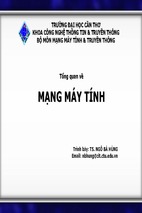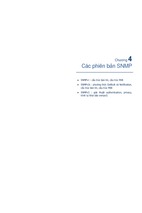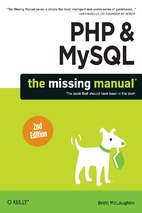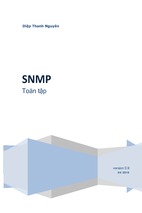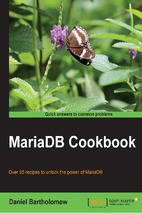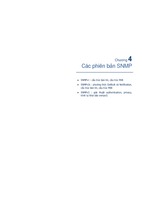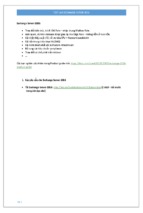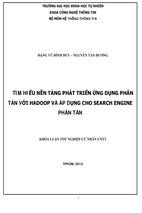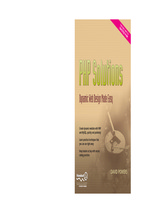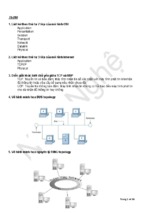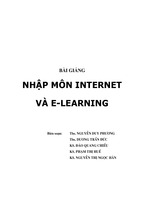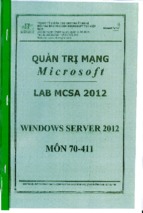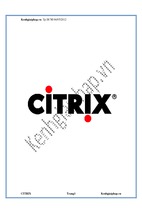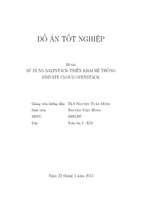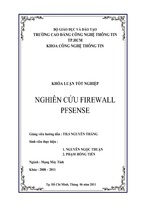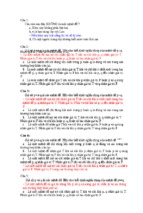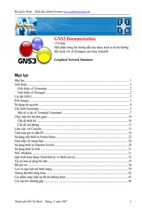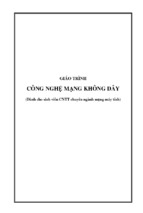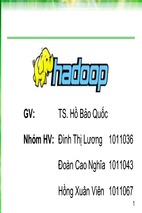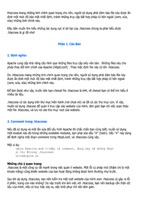IBML
Using MQSeries on the AS/400
Dieter Wackerow, Klaus Haaber-Bernth
International Technical Support Organization
http://www.redbooks.ibm.com
This book was printed at 240 dpi (dots per inch). The final production redbook with the RED cover will
be printed at 1200 dpi and will provide superior graphics resolution. Please see “How to Get ITSO
Redbooks” at the back of this book for ordering instructions.
SG24-5236-00
IBML
SG24-5236-00
International Technical Support Organization
Using MQSeries on the AS/400
July 1998
Take Note!
Before using this information and the product it supports, be sure to read the general information
in Appendix B, “Special Notices” on page 193.
First Edition (July 1998)
This edition applies to MQSeries for AS/400 Version 4 Release 2.
Comments may be addressed to:
IBM Corporation, International Technical Support Organization
Dept. HZ8 Building 678
P.O. Box 12195
Research Triangle Park, NC 27709-2195
When you send information to IBM, you grant IBM a non-exclusive right to use or distribute the
information in any way it believes appropriate without incurring any obligation to you.
Copyright International Business Machines Corporation 1998. All rights reserved.
Note to U.S. Government Users — Documentation related to restricted rights — Use, duplication or
disclosure is subject to restrictions set forth in GSA ADP Schedule Contract with IBM Corp.
Contents
Figures
. . . . . . . . . . . . . . . . . . . . . . . . . . . . . . . . . . . . . . . .
Tables
. . . . . . . . . . . . . . . . . . . . . . . . . . . . . . . . . . . . . . .
Preface
. . . . . . . . . . . . . . . .
The Team That Wrote This Redbook
. . . . . . . .
Comments Welcome
. . . . . . . . . . . . . . . . . . . . . . .
. . . . . . . . . . . . . . . . . . . . . .
. . . . . . . . . . . . . . . . . . . . . .
Chapter 1. Why Should You Use MQSeries on an AS/400?
.
1.1 Is MQSeries Just Another AS/400 Queuing System? . . .
1.2 About MQSeries for AS/400 Version 4 Release 2 . . . . .
1.3 MQSeries V5 and MQSeries for AS/400 V4R2 . . . . . . .
1.4 What Is Familiar in MQSeries to the AS/400 Professional?
. . . . . . . . . . .
1.4.1 Asynchronous Application Design
1.4.2 Message and Message Descriptor . . . . . . . . . . .
. . . . . . . . . .
1.4.3 Retrieving Messages from Queues
1.4.4 Remote Data Queues . . . . . . . . . . . . . . . . . . .
. . . . . . . . . . . . .
1.4.5 MQSeries Queues Are Secure
. . . . . . .
1.4.6 MQSeries Clients and ClientAccess/400
. . . . . . . .
1.4.7 MQSeries Objects Are AS/400 Objects
. . . . . . . . . . . . . . .
1.4.8 MQSeries Queue Manager
Chapter 2. MQSeries Overview . . . . . . .
2.1 What Is Messaging and Queuing? . . .
2.1.1 Messages . . . . . . . . . . . . . . .
2.1.2 Queue Manager . . . . . . . . . . .
2.1.3 MQSeries Objects . . . . . . . . . .
2.2 Message Queues . . . . . . . . . . . . .
2.2.1 Local Queue . . . . . . . . . . . . .
2.2.2 Remote Queue . . . . . . . . . . . .
. . . . . . . .
2.2.3 Transmission Queue
2.2.4 Dynamic Queue . . . . . . . . . . .
2.2.5 Model Queue . . . . . . . . . . . . .
. . . . . . . . . . . . .
2.2.6 Alias Queue
. . . . . . . . . . .
2.2.7 Initiation Queue
2.2.8 Reply-To Queue . . . . . . . . . . .
. . . . . . . . .
2.2.9 Dead-Letter Queue
2.3 Creating a Queue Manager . . . . . . .
2.4 Manipulating MQM Objects (RUNMQSC)
. . . . . . . . . . .
2.5 Clients and Servers
2.6 How MQSeries Works . . . . . . . . . .
Copyright IBM Corp. 1998
. . . . . . .
. . . . . . .
. . . . . . .
. . . . . . .
. . . . . .
. . . . . . .
. . . . . . .
. . . . . . .
. . . . . . .
. . . . . . .
. . . . . . .
. . . . . . .
. . . . . . .
. . . . . . . . . . . . . . . . . .
. . . . . . . . . . . . . . . . . .
. . . . . . . . . . . . . . . . . .
. . . . . . . . . . . . . . . . . .
. . . . . . . . . . . . . . . . . .
. . . . . . . . . . . . . . . . . .
. . . . . . . . . . . . . . . . . .
. . . . . . . . . . . . . . . . . .
. . . . . . . . . . . . . . . . . .
. . . . . . . . . . . . . . . . . .
. . . . . . . . . . . . . . . . . .
. . . . . . . . . . . . . . . . . .
. . . . . . . . . . . . . . . . . .
. . . . . . . . . . . . . . . . . .
. . . . . . . . . . . . . . . . . .
. . . . . . . . . . . . . . . . . .
. . . . . . . . . . . . . . . . .
. . . . . . . . . . . . . . . . . .
. . . . . . . . . . . . . . . . . .
ix
xiii
xv
xv
xvi
1
1
2
3
4
4
4
4
4
5
5
5
6
7
8
8
9
11
12
12
12
13
13
13
13
14
14
14
14
17
19
21
iii
2.7 Communication between Queue Managers
. . . . . . .
2.7.1 How to Define a Connection between Two Systems
. . . . . . .
2.7.2 How to Start Communication Manually
. . . . . . . .
2.7.3 How to Start Channels Automatically
. . . . . .
2.7.4 How to Start Applications Automatically
2.7.5 How to Test if the Queue Manager Is Working . . .
2.8 Communication between Client and Server . . . . . . .
2.8.1 How to Define a Client/Server Connection . . . . .
. . . . . .
2.8.2 How to Start a Client/Server Connection
. . . . . .
2.8.3 How to Test a Client/Server Connection
2.8.4 How a Client/Server Connection Works . . . . . . .
2.9 The Message Queuing Interface (MQI) . . . . . . . . . .
2.9.1 A Code Fragment . . . . . . . . . . . . . . . . . . . .
Chapter 3. AS/400 for Beginners . . . . . . . . . . . . . . .
3.1 Signing On . . . . . . . . . . . . . . . . . . . . . . . . . .
3.2 Main Menu and Command Entry Panel . . . . . . . . .
3.3 Understanding the 5250 Screen Layout . . . . . . . . .
3.4 Using Commands . . . . . . . . . . . . . . . . . . . . . .
3.4.1 Input Errors . . . . . . . . . . . . . . . . . . . . . . .
3.4.2 Executing a Command . . . . . . . . . . . . . . . .
. .
3.4.3 What Do I Do When Something Goes Wrong?
3.4.4 Shortcuts . . . . . . . . . . . . . . . . . . . . . . . .
3.5 Where Is the Error Log? . . . . . . . . . . . . . . . . . .
3.6 About Libraries . . . . . . . . . . . . . . . . . . . . . . .
3.6.1 Using Program Development Management (PDM)
3.7 About Library Lists . . . . . . . . . . . . . . . . . . . . .
3.7.1 System Library List . . . . . . . . . . . . . . . . . .
. . . . . . . . . . . . . . . . . . . .
3.7.2 Product Library
. . . . . . . . . . . . . . . . . . . .
3.7.3 Current Library
3.7.4 User Library List . . . . . . . . . . . . . . . . . . . .
. .
3.8 More Job Attributes and Where They Come From
3.8.1 General Job Attributes . . . . . . . . . . . . . . . .
3.8.2 Specific Job Attributes . . . . . . . . . . . . . . . .
3.8.3 When Is It Decided What Job Atttributes to Use .
3.9 Where Is the Editor? . . . . . . . . . . . . . . . . . . . .
3.10 How Do I Compile? . . . . . . . . . . . . . . . . . . . .
. . . . . . . . . . . . .
3.11 Did the Program Compile OK?
. . . . . . . . . . . . . . . . . .
3.12 Where Is the Printout?
. . . . . . . . . . . . . . . . . .
3.13 Basic AS/400 Security
3.14 Basic AS/400 Backup and Recovery . . . . . . . . . .
3.14.1 Securing Data with Backups . . . . . . . . . . . .
. . . . . . . . .
3.14.2 Securing Data between Backups
. . . . . .
3.14.3 Securing Data between Transactions
iv
Using MQSeries on the AS/400
. . . . . . . .
. . . . . . .
. . . . . . . .
. . . . . . . .
. . . . . . . .
. . . . . . . .
. . . . . . . .
. . . . . . . .
. . . . . . . .
. . . . . . . .
. . . . . . . .
. . . . . . . .
. . . . . . . .
. . . . . . . . .
. . . . . . . . .
. . . . . . . . .
. . . . . . . . .
. . . . . . . . .
. . . . . . . . .
. . . . . . . . .
. . . . . . . . .
. . . . . . . . .
. . . . . . . . .
. . . . . . . . .
. . . . . . . .
. . . . . . . . .
. . . . . . . . .
. . . . . . . . .
. . . . . . . . .
. . . . . . . . .
. . . . . . . . .
. . . . . . . . .
. . . . . . . . .
. . . . . . . . .
. . . . . . . . .
. . . . . . . . .
. . . . . . . . .
. . . . . . . . .
. . . . . . . . .
. . . . . . . . .
. . . . . . . . .
. . . . . . . . .
. . . . . . . . .
23
24
26
27
29
30
31
31
34
34
35
39
41
45
45
46
47
49
53
53
53
54
55
56
58
63
63
65
65
65
67
67
67
68
68
71
73
73
74
76
76
77
80
3.14.4 Journal Receiver Management
. . . . . . . . . . . . . . . . . . .
Chapter 4. Installation and Migration
. . . . . . . . . . . . . . .
. . . . . . . . . . . .
4.1 Considerations Before the Installation
4.1.1 Coded Character Set Identifier (QCCSID) . . . . . . . .
4.1.2 Language Identifier (QLANGID) . . . . . . . . . . . . . .
4.1.3 Coordinated Universal Time Offset (QUTOFFSET) . . .
4.1.4 System Part of the Library List (QSYSLIBL) . . . . . .
4.1.5 User Part of the Library List (QUSRLIBL) . . . . . . . .
4.1.6 Allow Object Restore Option (QALWOBJRST) . . . . .
4.2 Installation . . . . . . . . . . . . . . . . . . . . . . . . . . . . .
4.3 PTFs (Program Temporary Fixes) . . . . . . . . . . . . . . .
4.4 Verifying the Installation of 5769MQ1 . . . . . . . . . . . . .
. . . . . . . . . . . . . . . . .
4.5 Creating the Queue Manager
. . . . . . . . . . . . . . . . . . . .
4.5.1 Choosing the CCSID
4.5.2 What Is the CCSID for My Language? . . . . . . . . . .
. . . . . . . . . . .
4.5.3 Choosing a Queue Manager Name
. . . . . . . . . . . . . . . . . . . .
4.5.4 The CRTMQM Panel
4.5.5 Creating and Starting the MQM . . . . . . . . . . . . . .
. . . . . . . . . . . .
4.5.6 Creating the Default Environment
4.5.7 Deleting the Queue Manager . . . . . . . . . . . . . . .
4.6 Client Software for Clients Connected to the AS/400 . . . .
. . . . . . . . . . . . . . . . . . . . . . . .
4.7 Migrating to V4R2
. . . . . . . . . . . . . . . . . .
4.7.1 Preparing for Migration
. . . . . . . . . . . . . . . .
4.7.2 Update Product Code Only
. . . . . . . . .
4.7.3 Upgrade Product Code and Definitions
4.7.4 Upgrade Product Code, Definitions and Message Data
Chapter
5.1 MQ
5.2 MQ
5.2.1
5.2.2
5.2.3
5.2.4
5. Security Considerations
. . . .
. . . . . . . . .
Command Security
User Profiles . . . . . . . . . . . . .
The MQ Administrator (MQADM) .
.
The MQ Programmer (MQPGM)
The Application User (Otto, Eva, ...)
The Operator (QSYSOPR, MQOPR)
. . . . . .
. . . . . .
. . . . . .
. . . . . .
. . . . . .
. . . . . .
. . . . . .
. . . . . .
. . . . . .
. . . . . .
. . . . . .
. . . . . .
. . . . . .
. . . . . .
. . . . . .
. . . . . .
. . . . . .
. . . . . .
. . . . . .
. . . . .
. . . . .
. . . . .
. . . . .
. . . . .
. . . . .
. . . . . . . . . . . . . . . . .
. . . . . . . . . . . . . . . . .
. . . . . . . . . . . . . . . . .
. . . . . . . . . . . . . . . . .
. . . . . . . . . . . . . . . . .
. . . . . . . . . . . . . . . .
. . . . . . . . . . . . . . . .
Chapter 6. Running the Samples . . . . . . . .
. . . . . . . . .
6.1 Creating the MQ Manager
6.2 Creating the Environment for the Samples
6.3 Working with the RPG Sample Programs
6.3.1 Copy Source of the Sample Programs
6.3.2 Compile the RPG Programs . . . . . .
6.4 Executing the Sample Programs . . . . . .
6.4.1 Write Messages to a Queue . . . . . .
. . . . . . . . . . . . . . .
. . . . . . . . . . . . . . .
. . . . . . . . . . . . . . .
. . . . . . . . . . . . . . .
. . . . . . . . . . . . . . .
. . . . . . . . . . . . . . .
. . . . . . . . . . . . . . .
. . . . . . . . . . . . . . .
Contents
81
83
83
83
84
84
84
84
85
85
88
91
93
93
94
95
95
97
98
99
100
100
101
104
104
105
107
108
110
112
113
114
115
117
117
118
121
121
123
124
125
v
6.4.2 Browse Messages in a Queue
. . . . . . . . . .
. . . . . . . . . . .
6.4.3 Get Messages from a Queue
. . . . . . . . . . . . . . . . . .
6.5 Triggering a Program
6.5.1 Create a Sample Program . . . . . . . . . . . . .
6.5.2 Create a Triggered Queue . . . . . . . . . . . . .
. . . . . . . . . . . . . . . . . .
6.5.3 Create a Process
6.5.4 Start Program that Monitors the Initiation Queue
6.5.5 Put Messages into Triggered Queue . . . . . . .
6.5.6 Watch the Monitor Program . . . . . . . . . . . .
6.5.7 Monitoring in Batch . . . . . . . . . . . . . . . . .
6.6 More Sample Programs . . . . . . . . . . . . . . . . .
6.7 Inspecting Some Code . . . . . . . . . . . . . . . . . .
6.8 Syncpoint and AS/400 Commit Control . . . . . . . .
. . . . . . . . .
. . . . . . . . .
. . . . . . . . .
. . . . . . . . .
. . . . . . . . .
. . . . . . . . .
. . . . . . . .
. . . . . . . . .
. . . . . . . . .
. . . . . . . . .
. . . . . . . . .
. . . . . . . . .
. . . . . . . . .
Chapter 7. AS/400 Communicating with Other Systems
. . . .
. . . . . . . . . . . . . . .
7.1 AS/400 Communications Objects
7.2 MQSeries for AS/400 Using SNA . . . . . . . . . . . . . . . .
7.3 MQSeries for AS/400 Using TCP/IP . . . . . . . . . . . . . .
7.4 Example: Connecting MQSeries for AS/400 to Windows NT
7.4.1 Defining the AS/400 MQ Environment . . . . . . . . . .
7.4.2 Defining the Windows NT MQ Environment . . . . . . .
7.4.3 Sending and Receiving Messages . . . . . . . . . . . .
7.4.4 Monitoring Channels . . . . . . . . . . . . . . . . . . . .
Chapter 8. Operating MQSeries for AS/400 . . . . . . .
8.1 Handling Journal Objects in Backup and Recovery
8.1.1 MQ Journals . . . . . . . . . . . . . . . . . . . .
. . . . . .
8.1.2 Recovering a Damaged MQ Object
. . . . . . . . . . . . . . . . . .
8.2 Channel Operations
8.3 Starting MQ Operations . . . . . . . . . . . . . . . .
. . . . . . . . . . . . . . .
8.4 Stopping MQ Operations
Chapter 9. MQSeries Administration . . . . . . .
. . .
9.1 CL Commands for MQ Administration
9.2 Use of MQSC Commands . . . . . . . . . . .
9.3 MQSeries for AS/400 Administration Utility
9.4 Administering an AS/400 from a Remote Site
Chapter 10. Service and Trace
. .
10.1 Before Contacting IBM Service
. . .
10.2 Contacting IBM Service
Using MQSeries on the AS/400
. . . . .
. . . . .
. . . . .
. . . . .
. . . . .
. . . . .
. . . . .
. . . . . . . . . .
. . . . . . . . .
. . . . . . . . . .
. . . . . . . . . .
. . . . . . . . . .
. . . . . . . . . .
. . . . . . . . . .
. . . . . . . . . . . . . .
. . . . . . . . . . . . . .
. . . . . . . . . . . . . .
. . . . . . . . . . . . . .
. . . . . . . . . . . . .
. . . . . . . . . . . . . . . . . . . . . .
. . . . . . . . . . . . . . . . . . . . .
. . . . . . . . . . . . . . . . . . . . . .
Appendix A. Sample Programs . . . . . . . . . . . . . . .
A.1 SWK - Display Active Jobs in Subsystem QSYSWRK
vi
. . . . .
. . . . .
. . . . . . . . .
. . . . . . . .
127
128
129
129
130
130
130
130
131
132
134
136
137
141
141
143
145
146
147
149
150
151
153
153
154
156
159
162
163
167
167
169
169
175
177
182
186
187
187
A.2
A.3
A.4
A.5
A.6
A.7
A.8
A Simple File: FILA
. . . . . . . . . . . . . . . .
A Simple RPG Program with Commit Control .
DTA2 - Put Date and Time in a Data Area . . .
TCJOB - Save Keying Time When Tracing a Job
Starting MQ Manager . . . . . . . . . . . . . . .
Ending MQ Manager . . . . . . . . . . . . . . . .
. . . . . . . . . . . .
Starting Sender Channels
Appendix B. Special Notices
. . . . . . . . . . . .
187
187
188
189
190
191
192
. . . . . . . . . . . . . . . . . . . . . . . . .
193
. . . . . . . . . . . .
. . . . . . . . . . . .
. . . . . . . . . . . .
. . . . . . . . . . .
. . . . . . . . . . . .
. . . . . . . . . . . .
Appendix C. Related Publications
. . . . . . . . . . . . . . . .
C.1 International Technical Support Organization Publications
C.2 Redbooks on CD-ROMs . . . . . . . . . . . . . . . . . . . .
C.3 Other Publications . . . . . . . . . . . . . . . . . . . . . . .
How to Get ITSO Redbooks
. . . . . . . . . .
How IBM Employees Can Get ITSO Redbooks
How Customers Can Get ITSO Redbooks . .
. . . . . . . . . . .
IBM Redbook Order Form
. . . . .
. . . . . .
. . . . . .
197
197
197
197
. . . . . . . . . . . . . . . .
199
199
200
201
. . . . . . . . . . . . . . . . . . . . . . . . . . . . . .
203
. . . . . . . . . . . . . . . . . . . . . . . . . . . . . . . . . . . . . . . .
205
List of Abbreviations
Index
. . . . . .
ITSO Redbook Evaluation
. . . . . . . . . . . . . . . .
. . . . . . . . . . . . . . .
. . . . . . . . . . . . . . . .
. . . . . . . . . . . . . . . . . . . . . . . . . . . .
Contents
207
vii
viii
Using MQSeries on the AS/400
Figures
1.
2.
3.
4.
5.
6.
7.
8.
9.
10.
11.
12.
13.
14.
15.
16.
17.
18.
19.
20.
21.
22.
23.
24.
25.
26.
27.
28.
29.
30.
31.
32.
33.
34.
35.
36.
37.
38.
39.
40.
41.
MQSeries at Runtime
. . . . . . . . . . . . . . . . . .
Program-to-Program Communication - One System
Program-to-Program Communication - Two Systems
. . . . . . . . . . . . . . . . .
RUNMQSC - Interactive
RUNMQSC - Using Command File . . . . . . . . . . .
RUNMQSC - Input File, or AS/400 STRMQMMQSC
RUNMQSC - Output File, or AS/400 WRKSPLF . . .
. . . . . . . . . . . . . . . . . . .
MQSeries Channels
. . . . . . . . . . . . . . .
MQSeries Parts and Logic
. .
Communication between Two Queue Managers
AS/400 MQ CL Definitions . . . . . . . . . . . . . . . .
. . . . . . . . . . . . . . . . . . .
Triggering Channels
. . . . . . . . . . . . . . . . .
Triggering Applications
. . . . . . . . . . . . . .
Testing the Queue Manager
. . . . . . . . . . . . . . . .
Client/Server Connection
. . . . . . . . . . .
Definitions for Server Connection
. . . . . . . . . . .
Testing Client/Server Connection
Listener Window (RUNMQLSR) . . . . . . . . . . . . .
. . . . . . . . . . . . . . . . . . . .
Clients and Server
. . . . . . . .
Definitions for Two Clients and Server
. . . . . . . . .
Fragments of an MQSeries Program
. . . . . . . . . . . . . . . . . .
AS/400 Sign On Panel
AS/400 Main Menu . . . . . . . . . . . . . . . . . . . .
. . . . . . . . . . . . .
AS/400 Command Entry Panel
. . . . . . . . . . . . . .
Work with Active Jobs Panel
Create Job Description Panel . . . . . . . . . . . . . .
. . . . . .
Create Job Description Panel - Keywords
Create Job Description Panel - More Keywords . . .
. . . . . . . . . .
Panel to Specify More Parameters
Panel with Errors . . . . . . . . . . . . . . . . . . . . .
. . . . . . . . . . . . . . . . .
Select Command Panel
Display Job Log Panel . . . . . . . . . . . . . . . . . .
. . . . . . . . . . . . . .
Display All Messages Panel
Work with Object Links Panel . . . . . . . . . . . . . .
. . . . . . . . .
Work with Objects Using PDM Panel
. . . . . . . . .
Work with Objects Using PDM Panel
. . . . . . . .
Work with Members Using PDM Panel
. . . . . . . . . . . . . . . . . . . . . . .
Browse Panel
. . . . . . .
Display Physical File Member Panel (1)
. . . . . . .
Display Physical File Member Panel (2)
Display Library List . . . . . . . . . . . . . . . . . . . .
Copyright IBM Corp. 1998
. . . . . . . . .
. . . . . . . . .
. . . . . . . .
. . . . . . . . .
. . . . . . . . .
. . . . . . . . .
. . . . . . . . .
. . . . . . . . .
. . . . . . . . .
. . . . . . . . .
. . . . . . . . .
. . . . . . . . .
. . . . . . . . .
. . . . . . . . .
. . . . . . . . .
. . . . . . . . .
. . . . . . . . .
. . . . . . . . .
. . . . . . . . .
. . . . . . . . .
. . . . . . . . .
. . . . . . . . .
. . . . . . . . .
. . . . . . . . .
. . . . . . . . .
. . . . . . . . .
. . . . . . . . .
. . . . . . . . .
. . . . . . . . .
. . . . . . . . .
. . . . . . . . .
. . . . . . . . .
. . . . . . . . .
. . . . . . . . .
. . . . . . . . .
. . . . . . . . .
. . . . . . . . .
. . . . . . . . .
. . . . . . . . .
. . . . . . . . .
. . . . . . . . .
7
9
9
17
18
18
19
20
22
24
26
28
29
31
32
33
35
35
36
38
42
45
46
47
48
49
50
51
52
53
54
55
56
57
59
59
60
61
62
62
64
ix
42.
43.
44.
45.
46.
47.
48.
49.
50.
51.
52.
53.
54.
55.
56.
57.
58.
59.
60.
61.
62.
63.
64.
65.
66.
67.
68.
69.
70.
71.
72.
73.
74.
75.
76.
77.
78.
79.
80.
81.
82.
83.
84.
85.
x
Edit Library List . . . . . . . . . . . . . . . . .
. . . . . . .
Work with Members Using PDM
. . . . . . . . . . . . .
Edit an RPG Program
Create a Program Panel . . . . . . . . . . . .
Work with Output Queue Panel . . . . . . . .
. . . . . .
Edit Object Authority - Example 1
. . . . . .
Edit Object Authority - Example 2
. . . . . . . . .
Display Software Resources
. . . . .
Install Licensed Programs - View 1
. . . . .
Install Licensed Programs - View 2
PTF Listing . . . . . . . . . . . . . . . . . . . .
. . . . . . . . . . . . . . .
Display PTF Status
Display Job Definition Attributes . . . . . . .
List of Language IDs (LANGID) . . . . . . . .
. . . . . .
Create Message Queue Manager
Create Message Queue Manager (After F11)
Display Message Queue Manager . . . . . .
Display Message Queue Manager . . . . . .
. . . . .
Security - Not Authorized Message
Display MQM Object Authority . . . . . . . .
Create User Profile Panel . . . . . . . . . . .
. . . . . . . . . . . . .
MQSeries Commands
. . . . . .
Create Message Queue Manager
Work with MQM Queues . . . . . . . . . . . .
Display MQM Queue . . . . . . . . . . . . . .
. . . . . . . .
Work with Objects Using PDM
. . . . . . . . . . . . . . . . . .
Copy Objects
. . . . . . .
Work with Members Using PDM
.
Create RPG/400 Program (CRTRPGPGM)
CALL AMQ1PUT4 . . . . . . . . . . . . . . . .
. . . . . . .
MQSeries Work with Messages
. . . . . . . . .
Display MQM Message Data
. . . . . . . . . . . . . .
Display Spooled File
. . . . . . . . . . . . . .
Display Spooled File
AMQSERV4 Writing to STDOUT . . . . . . . .
Work with Active Jobs, PGM-AMQSERV4 . .
Work with Active Jobs, PGM-DTA2 . . . . . .
Change MQM Process (CHGMQMPRC) . . .
Work with Communication Resources . . . .
Add Routing Entry . . . . . . . . . . . . . . . .
Create Comm Side Information . . . . . . . .
STRMQMMQSC Definitions . . . . . . . . . .
STRMQMMQSC Error Report . . . . . . . . .
Work with MQM Channels . . . . . . . . . . .
Using MQSeries on the AS/400
. . . . . . . . . . . . . .
. . . . . . . . . . . . . .
. . . . . . . . . . . . . .
. . . . . . . . . . . . . .
. . . . . . . . . . . . . .
. . . . . . . . . . . . . .
. . . . . . . . . . . . . .
. . . . . . . . . . . . . .
. . . . . . . . . . . . . .
. . . . . . . . . . . . . .
. . . . . . . . . . . . . .
. . . . . . . . . . . . . .
. . . . . . . . . . . . . .
. . . . . . . . . . . . . .
. . . . . . . . . . . . . .
. . . . . . . . . . . . .
. . . . . . . . . . . . . .
. . . . . . . . . . . . . .
. . . . . . . . . . . . .
. . . . . . . . . . . . .
. . . . . . . . . . . . .
. . . . . . . . . . . . .
. . . . . . . . . . . . .
. . . . . . . . . . . . .
. . . . . . . . . . . . .
. . . . . . . . . . . . .
. . . . . . . . . . . . .
. . . . . . . . . . . . .
. . . . . . . . . . . . .
. . . . . . . . . . . . .
. . . . . . . . . . . . .
. . . . . . . . . . . . .
. . . . . . . . . . . . .
. . . . . . . . . . . . .
. . . . . . . . . . . . .
. . . . . . . . . . . . .
. . . . . . . . . . . . .
. . . . . . . . . . . . .
. . . . . . . . . . . . .
. . . . . . . . . . . . .
. . . . . . . . . . . . .
. . . . . . . . . . . . .
. . . . . . . . . . . . .
. . . . . . . . . . . . .
66
69
71
72
74
75
76
86
87
87
89
90
93
94
96
96
97
98
109
110
111
113
118
120
120
122
122
124
123
126
126
127
128
129
131
132
133
135
142
143
144
148
148
151
86.
87.
88.
89.
90.
91.
92.
93.
94.
95.
96.
97.
98.
99.
100.
101.
102.
103.
104.
105.
106.
107.
108.
109.
110.
111.
112.
113.
114.
115.
116.
MQSeries Work with Channels Status . .
. . . . . . . . . .
Display Journal Entries
. . . . . .
Work with Objects Using PDM
Work with MQM Channels . . . . . . . . .
MQSeries Work with Channels Status . .
Ping MQM Channel (PNGMQMCHL) . . .
. . . . . . . . . . .
MQSeries Commands
. . . . . . . . . . . . .
Select Commands
. . . . . . . . .
Start MQM Administrator
. . . . . . . . .
MQSeries Administration
Add Queue Manager Panel . . . . . . . .
. . . . . . . . .
MQSeries Administration
. . . . . . . . . .
MQSeries Object Types
. . . . . . . . .
MQSeries Display Queue
MQSeries Work with Objects . . . . . . .
Work with MQM Queues . . . . . . . . . .
. . . . . . . . .
MQSeries Administration
MQSeries Wait for Remote Data . . . . .
. . . . . . .
Display MQM Message Data
. . . . . . .
Display MQM Message Data
. . . . . . . . . . .
Work with Job Queue
Work with Active Jobs . . . . . . . . . . .
Work with Output Queue . . . . . . . . . .
. . . . . . . . . . . .
Display Spooled File
. . . . . . . . . . . . . .
MQ Trace Listing
PTF Listing . . . . . . . . . . . . . . . . . .
Display Program Temporary Fix (DSPPTF)
. . . . . . . . . . . . .
Display PTF Status
. . . . . . . . . . . .
Work with Problems
Display Problem Details . . . . . . . . . .
Work with Problem . . . . . . . . . . . . .
. . . . . . . . . . . . . . .
. . . . . . . . . . . . . . .
. . . . . . . . . . . . . . .
. . . . . . . . . . . . . . .
. . . . . . . . . . . . . . .
. . . . . . . . . . . . . . .
. . . . . . . . . . . . . . .
. . . . . . . . . . . . . . .
. . . . . . . . . . . . . . .
. . . . . . . . . . . . . . .
. . . . . . . . . . . . . . .
. . . . . . . . . . . . . . .
. . . . . . . . . . . . . . .
. . . . . . . . . . . . . . .
. . . . . . . . . . . . . . .
. . . . . . . . . . . . . . .
. . . . . . . . . . . . . . .
. . . . . . . . . . . . . . .
. . . . . . . . . . . . . . .
. . . . . . . . . . . . . . .
. . . . . . . . . . . . . . .
. . . . . . . . . . . . . . .
. . . . . . . . . . . . . . .
. . . . . . . . . . . . . . .
. . . . . . . . . . . . . . .
. . . . . . . . . . . . . . .
. . . . . . . . . . . . . .
. . . . . . . . . . . . . . .
. . . . . . . . . . . . . . .
. . . . . . . . . . . . . . .
. . . . . . . . . . . . . . .
Figures
152
157
158
159
161
161
168
168
170
171
171
172
172
173
173
174
174
175
176
176
178
178
180
180
181
182
183
183
185
185
186
xi
xii
Using MQSeries on the AS/400
Tables
1.
2.
3.
4.
5.
6.
7.
8.
9.
10.
11.
MQSeries Objects for MQM-to-MQM Connection . . . .
. . . . . . . . . . . . . .
Start MQM-to-MQM Connection
MQSeries Definitions to Start Channels . . . . . . . . . .
AS/400 Sample Programs and Programming Languages
AS/400 Commit/Rollback Commands . . . . . . . . . . .
Files Changed in V4R2 . . . . . . . . . . . . . . . . . . . .
Case-Sensitive MQMNAME . . . . . . . . . . . . . . . . .
Files Changed in V4R2 . . . . . . . . . . . . . . . . . . . .
. . .
Definitions for Connecting Windows NT to AS/400
. . . . . . . . . . . . . . . . . . . . . . . .
Channel Status
MQSeries Processes . . . . . . . . . . . . . . . . . . . . .
Copyright IBM Corp. 1998
. . . . . . .
. . . . . . .
. . . . . . .
. . . . . .
. . . . . . .
. . . . . . .
. . . . . . .
. . . . . .
. . . . . .
. . . . . .
. . . . . .
25
27
28
30
40
92
95
105
146
160
163
xiii
xiv
Using MQSeries on the AS/400
Preface
This redbook will help you get started with MQSeries for AS/400 V4R2. It
explains why and how to use MQSeries with the OS/400 operating system
and shows that MQSeries is more than just another AS/400 queuing system.
The book is written for two audiences:
•
Persons who know the AS/400 but have only a little understanding of
MQSeries and how to use it
•
Persons who know MQSeries but not the AS/400 and need some extra
guidance on how to use OS/400 with MQSeries
This redbook includes an overview of MQSeries explaining its architecture,
how to connect clients to servers and servers to servers, how to trigger
applications, and the MQI programming interface. Another chapter explains
to AS/400 novices how to get started using OS/400. It describes the
command interface, how the libraries are used and how to edit, compile and
test a program.
The book provides detailed information on installation and migration you
cannot find anywhere else. It contains guidelines about what user types
require what authority to work with MQSeries objects.
This redbook explains what has to be done to use MQSeries for
communication between an AS/400 and other platforms, such as Windows
NT. It provides examples that guide you through the administrative process
of defining connections between different systems.
It also contains guidelines for daily MQSeries operations, such as
journaling, making backups, and defining MQSeries objects to support new
applications. Information regarding security, backup, restore and recovery
are also included.
The Team That Wrote This Redbook
This redbook was produced by a team of specialists from around the world
working at the Systems Management and Networking ITSO Center, Raleigh.
Klaus Haaber-Bernth is a Senior Systems Engineer in the Service
Organization in IBM Sweden. He holds a degree in Chemical Engineering
from the Technical University in Copenhagen. He has worked on AS/400
and the previous systems S/38, S/36, S/34, S/32 and S/3 in his 30 years with
IBM. Klaus has been in the Industry Segment and in AS/400 Marketing. He
has conducted courses in Communications, Performance and Systems
Copyright IBM Corp. 1998
xv
Design. He has also been on a residency in Rochester with Journaling.
One of his present tasks in Sweden is services around the Year 2000
challenge for AS/400 customers and Business Partners.
Dieter Wackerow is an Advisory ITSO Specialist for MQSeries at the
Systems Management and Networking ITSO Center, Raleigh. His areas of
expertise include application design and development for various industries,
performance evaluations, capacity planning, and modelling of computer
systems and networks. He also wrote a simulator for banking hardware and
software. He taught classes and has written on performance issues,
application development and about MQSeries.
Thanks to the following people for their invaluable contributions to this
project:
Gottfried Schimunek
International Technical Support Organization, Rochester Center
Hubert T. Lye
IBM Australia
Comments Welcome
Your comments are important to us!
We want our redbooks to be as helpful as possible. Please send us your
comments about this or other redbooks in one of the following ways:
•
Fax the evaluation form found in “ITSO Redbook Evaluation” on
page 207 to the fax number shown on the form.
•
Use the electronic evaluation form found on the Redbooks Web sites:
For Internet users
For IBM Intranet users
•
Send us a note at the following address:
[email protected]
xvi
http://www.redbooks.ibm.com/
http://w3.itso.ibm.com/
Using MQSeries on the AS/400
Chapter 1. Why Should You Use MQSeries on an AS/400?
The AS/400 operating system, OS/400, has already two queue systems,
message queues (MSGQ) and data queues (DTAQ). Message queues are
used for system and program messages for the operator. Data queues are
used to exchange data between applications in one or more AS/400
systems, and between an AS/400 and clients (PCs) using the Client Access
for AS/400 software. So, why should you use another queuing system,
MQSeries, on an AS/400?
1.1 Is MQSeries Just Another AS/400 Queuing System?
MQSeries means commercial messaging and queuing. It allows business
applications to integrate and communicate across a spectrum of desktop
and mainframe systems, overcoming inconsistencies with different network
protocols and all major commercial platforms. Key benefits of this
award-winning market leader are:
•
A single, multi-platform API
•
Isolation from communications programming
•
Time-independent processing
•
Assured message delivery, even when programs or networks fail
•
Robust middleware for high-performance distributed application
integration
MQSeries lets you break away from the constraints of differing technologies
while maintaining the benefits. It provides a scalable infrastructure
integrating distributed applications.
The key advantages of MQSeries over AS/400 data queuing are:
•
MQSeries message queues are secure. Persistent messages survive a
system restart.
•
MQSeries enables application programs running on different platforms
to communicate with each other using the Message Queuing Interface
(MQI) which is consistent over all platforms.
If the following issues are important to you, MQSeries for AS/400 Version 4
Release 2 is for you:
•
MQSeries is a product family for more than 25 different platforms. Data
queues and message queues are only for AS/400 and ClientAccess/400
PCs.
Copyright IBM Corp. 1998
1
•
Design, programming and administration is similar on different
MQSeries platforms.
•
An application written to MQSeries standards is more likely to be
portable to other platforms.
•
MQSeries for AS/400 can store queue data persistently. AS/400
standard data queues cannot.
•
MQSeries for AS/400 can synchronize transactions and AS/400
databases with commit/rollback. AS/400 standard data queues cannot.
•
Channel sequence checking between systems assures that no data is
lost (not implemented for AS/400 standard remote data queues).
•
MQSeries allows remote administration across platforms.
•
MQSeries for AS/400 uses both the standard MQSeries commands and
the OS/400 command interface, well known to AS/400 people.
•
MQSeries isolates the communication interface as easy as AS/400
standard data queue does.
•
MQSeries for AS/400 can browse a message (non-destructive read).
AS/400 data queues cannot.
•
Version 4 Release 2 of MQSeries for AS/400 uses the new heartbeat
function to keep channel management from waiting for nothing.
•
Version 4 Release 2 of MQSeries for AS/400 allows distribution lists to
minimize unnecessary data flow. Version 4 Release 2 of MQSeries for
AS/400 supports blocking and deblocking. This eliminates the need for
application blocking and deblocking, and thus makes it straightforward
to use commit/rollback for synchronizing queues and databases.
1.2 About MQSeries for AS/400 Version 4 Release 2
MQSeries for AS/400 Version 4 Release 2 is a new product, 5769-MQ1, with
new terms and conditions. A migration path is possible for these previous
versions of MQSeries for AS/400:
•
•
•
•
5733-103
5763-MQ1
5763-MQ2
5716-MQ1
V2:
V3R0.5 and V3R1:
V3R2:
V3R6:
for
for
for
for
OS/400
OS/400
OS/400
OS/400
V2R3
V3R0.5 and V3R1
V3R2
V3R7 and V4R1
V4.2 has a user-based price structure. A user is defined as a concurrent
MQSeries connection. An OS/400 job running an MQSeries application
counts as a user from the execution of MQCONN until MQDISC. Also an
MQSeries administration task counts as a user, when running.
2
Using MQSeries on the AS/400


